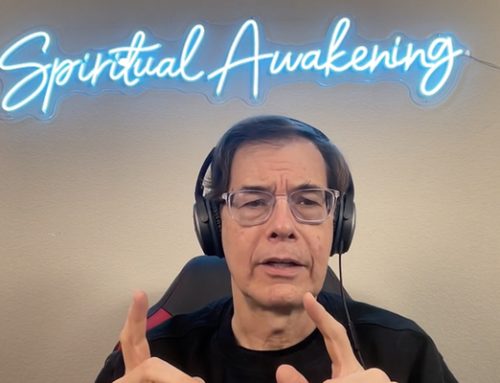A Beautiful Tuesday to You!
I had a lovely day yesterday and I hope you did too.
My day began with a lovely tai-chi session. After writing my blog, I headed to the gym for a lovely deadlift session.
After three days of rest and play in my rock garden, my whole body felt rejuvenated and the weights felt amazingly light.
That’s when I’ve got to be the most careful in the gym!I have a natural love for heavy lifting and can lift more than my body can handle sometimes. I got in six sets of deadlifting with high cable pulling and reptilian crawling in mini-circuits.
I spent the rest of the day reviewing my new Scientific Shoulder Training course manual and writing a final section on how to put the exercises together in a safe and functional way.
I’m really excited to release this new course, which has been several years in the making; it seems that every time we were making good progress, we ended up with technical difficulties in editing and/or production!
We now have all the editing complete and once I write the series of example programs to show how to progress a shoulder patient through the developmental steps, the new correspondence course will be complete and ready to share with the world.
I owe a lot of thanks and gratitude to Holli Spicer for taking on this very big task, for which she’s done a great job! Thank You Holli!
Over the past several days, I’ve been absorbed with an art project. I’m creating a thank you and seasons greetings card for each of my instructors.
There are about 20 of them and I was hoping to get them all done in three days. That was my naiveté at work; once my spirit gets hold of a pen and paper, all sorts of things begin to come forth and time disappears!
I managed to finish eight of them so far and will keep working on them each night until done. I’ve been coming home, doing my evening tai-chi, lighting a lovely fire and getting to my art.
I feel so blessed to be able to share my love through art.
MEDITATION TIPS
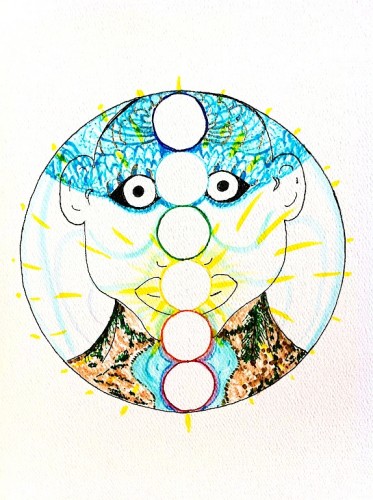
“Meditation” essentially means toward the center (of your Being).
Meditation is a practice that has proven to be quite challenging for the western mind; though there are plenty of “Eastern minds” that have challenges meditating as well.
As a practice, meditation is traditionally used in religious/spiritual practices for gaining realization and Union with the Over-Soul.
The Over-Soul may be expressed as The Witness – that which is behind your thoughts or sense of “self”.
Our sense of “self” is contained in, and expressed through the word “ego”. The ego is essentially that which defines or differentiates self from other.
Ego can also be referred to as that which creates boarder, barrier and definition.
Your ego is as unique as your fingerprints; there will never be any other with your finger prints in the universe and your ego is what allows you to realize and celebrate what you truly are.
Mystics throughout antiquity have implied that Love Is God and the reason God created Love was so that God could experience God in and as Love.
For there to be an experience of love, there need be a lover and a beloved. The lover and beloved equate to subject (consciousness of) and object (beloved).
Through a wide variety of forms of meditation practices, the meditator goes through many stages of “awareness”.
First, the meditator finds that their mind is a bundle of seemingly ceaseless activity.
As one meditates, they seek to “witness” what rises inside themselves, waiting patiently for the mind to calm.
With commitment to practice, the meditator often finds that they must express empathy and compassion for themselves.
It is as though the ego resists any attempt to let consciousness move beyond itself; the ego is like a child that gets jealous when another child is getting more attention.
Though this may seem to be quite a distraction, there is a deep lesson hidden in this process that many don’t acquire or understand because they don’t understand the nature of an ego to begin with.
When we reflect on the reality that God can only be truly conscious within you, and that there can be no “God” or any other to worship without the ego’s function of separating lover and beloved, the issue becomes clearer.
The journey inward is exemplified in my PPS Success Mastery teaching of “I” – “We” – “ALL”. We must first become clear as to who and what our “I” is.
Without developing awareness, understanding, and nurture for our “I’ness”, we can’t ever truly know ourselves.
Without knowing ourselves, we can never be more present in any “We” or “ALL” relationship than we can be with ourselves.
When we practice any form of meditation, we are first and foremost making a commitment to knowing ourselves.
If we find that our mind is jumpy and full of negative thoughts, we are learning from witnessing ourselves that we are jumpy and full of negative thoughts.
With practice and awareness, we realize that the person we meet in meditation, who is seemingly unable to hold still and be present, is the very person that is making our choices in life.
This is the person that invests your life force into the choices that largely determine your individual experience, while influencing the choices and experiences of all others we co-create life experiences with.
With regular, daily, committed practice, one begins to have breakthroughs. In the breakthroughs, one finds that behold, there is a witness behind the ego.
The witness behind the ego is witnessing all our follies, experiences and processes, yet, paradoxically, isn’t any of them.
When we meet the witness aspect of ourselves, we have met our very soul.
The meeting and experiencing of one’s soul is the beginning of the process of truly understanding the nature of a “We” relationship; you the ego and that within which is witnessing.
The “We” stage of meditative development is quite special. To get there, one has to have learned patience for the ego.
Patience becomes expressed through loving detachment. Once you realize that the witness is more conscious and present than the ego, there is a growing willingness to detach like a mother detaches from her children to let them play while she cooks – Mother detaches without being detached because she loves her children.
Most meditators don’t get to this exciting “We” stage in their meditative practices because they are unaware of the power and neediness of their own ego.
They often shun the ego because of being programmed to believe that the ego is bad, evil, negative and something to get rid of!
In reality, the ego acts like a pet dog or a child; when mother or father scorns it and tries to detach, the child clings and the dog barks and follows very closely for fear of losing its beloved.
The real secret (in my own experience) to getting beyond the initial “I” phase of meditation (ego struggling and mental masturbation!) is to embrace and care for the ego the way you embrace and care for someone you love deeply.
What does this require?
Well, to understand what this requires, let’s just imagine for a minute that your ego is a dog.
1. The ego-dog needs water. If it doesn’t have water it will bark and scratch at the door until it gets water.
If it doesn’t get water it will die due to lack of water, which is the equal of lack of love from its master.
2. The ego-dog needs food. If the dog doesn’t get fed, it will die slowly and painfully.
3. The ego-dog needs shelter or it will die of exposure.
4. The ego-dog needs warmth or it will die of exposure.
5. The ego-dog needs love (nature and nurture) or it will die of loneliness.
When people embark on the meditative path, in my experience, it usually comes after one or a potentially long series of life challenges.
In the process of such challenges, people often become very stressed.
Stress has a winding-up effect on the mind, which tends to cause the ego to focus on it’s perceptions and projections, at the expense of the ego’s authentic needs (ego-dog 1-5 above).
As we get caught up at the level of ego-mind, we tend to ignore the biological reality of our ego – our body – which is essential to the experience we all share here.
The key message for the beginning or challenged meditator here is that you will find that meditation is MUCH easier when the ego-dog is fed, watered, sheltered, warm and loved.
With these needs for nurture met, the biological aspects of the ego stop sending “HELP!” messages to the ego-mind.
The reduced mental activity that comes with authentically loving one’s “self” is significant for most people.
They don’t realize that much of the dance in their head is the misinterpretation of the requests and cries for help from the body aspect of the ego’s body-mind construct.
By feeding and caring for yourself in such a way that your ego-body isn’t a hindrance, it is much easier to calm and relax into a meditation of any type.
Once we’ve gained the stability of knowing that our body is loved and cared for, our next task is to be brave enough to let go of the world.
The ego loves to put itself in the center of every show. It has a million reasons why it should worry about this and that, what he said, what she did!
It is as though it convinces itself that it’s opinions are always right and it is needed to “save everyone else”, and any variety of self-generated stories.
To get deeper into your meditative practice, I suggest you be brave enough to do what you do every night while you are awake.
If you are like me, you go to bed and let go of the world completely every night, only to wake up and turn your story back on again.
Yet, now that it’s time to meditate, all the sudden the ego-mind wants to make sure you know about everyone’s dirty laundry, the politics of the world, and even your own issues of guilt, shame and blame!
It’s really a matter of self-discipline and having the clarity that your mind has delivered the reality you now live, which hasn’t changed much at all for most people.
If you are ready to grow and evolve into a more “human being”, then naturally you may be inclined to practice the methods that the most human of beings have taught us throughout antiquity.
The third stage of meditative evolution comes when the “We” stage is fully embraced. In the full embrace of “We”, you’ve learned to both love and trust the “witness”.
As you practice meditating, you will find that each moment of union with the witness generates significant amounts of peace and inner-calm.
It’s as though a complete sense of “knowing” that all is well regardless of what the “show looks like”.
These experiences are so stress relieving that time with the witness becomes akin to time on the breast for a newborn.
As this ego-witness relationship grows, the ego finds itself letting go more and more completely to the witness.
The ego learns, paradoxically, that talking isn’t needed, for the witness is one with your thoughts long before they produce words.
In that knowing and comfort, the love and trust emerges as a complete letting go of the ego.
There comes times when five minutes in marriage with the witness produces what seems like an eternity of rest, rejuvenation, tremendous mental clarity, and the confidence that life is beautiful, even perfect as it is.
The meditative process grows into the equivalent of relaxed sleeping while conscious and awake.
The witness is the soul while the view is one of ego looking out (or in) to the soul.
But once the ego learns to trust and let to to the witness, there is no longer a subject-object relationship between ego and soul.
Now, soul is your only conscious reality. As the experience of merging with the witness grows, the ego diminishes and it is as though your consciousness expands and expands and expands.
First you learn to understand yourself.
Then you learn to understand people and the world (usually out of empathy and compassion), then you become one with the world.
This goes on until one is conscious of Self in and as the Universe.
This is an amazing enough experience in itself to keep the meditator coming back very naturally and effortlessly. But it’s not the peak experience yet either!
Once one experiences themselves in union with the universe, the next step is to let go of the need for any such subject-object relationship.
This requires a tremendous amount of bravery, of spiritual courage.
The experience is as real as any reality you’ve ever known.
Without “object” relationships, we become one with Pure Consciousness. There is no-thing there. Not a universe, a world, nor any “other”. There’s not even a “you”.
I remember the first time I experienced this!it scared me deeply!
I didn’t know how long I was there, but all the sudden I was awakened out of purely “subject” into subject-object and it was as though a lightening bolt hit my body-mind.
I was somehow shot back into my body and my whole body literally jumped as though it was shocked by high voltage.
I was near the beach at the Self Realization Fellowship gardens in Encinitas.
The first thing I saw were dolphins jumping and playing in the waves.
What was most marvelous was the complete sense that I knew them as though they were my own family members.
I saw surfers surfing the same waves and as I watched each of them, I knew who they were, what their pains and challenges were, and could see all the love hidden below their pain creating the pressure that drives life.
With each progressive step in my own meditative practice, I’ve found it easier to re-member how to get back to that sacred place.
Over my lifetime of exploring a wide variety of meditative practices, I’ve found that there are many ways to get there.
I’ve found that the most important thing isn’t the method, it’s the commitment to the practice of healing the ego.
For me, it’s not because I desire to be different or better than others; that’s not a strong enough motive to make the journey I’ve described because the motive exemplifies the disease that keeps the ego-dog scratching at the door ceaselessly!
For me, it’s a deep desire to know the truth of life and what people refer to as “God”.
I’ve always found that there was a limit to the reach of other people’s opinions and that to feel safe, I need to take ownership of my own experience so that I feel safe sharing my experiences.
TIPS THAT MAY HELP YOU
Its helpful to engage in some activity that helps you to discharge excess energy before meditation.
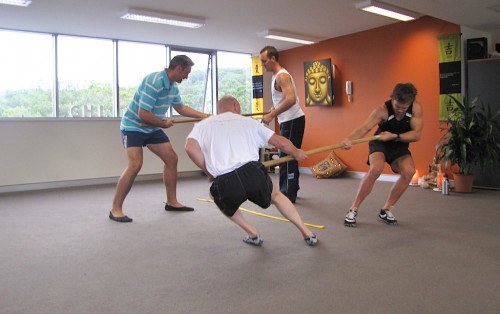
As you can see in my photos from Donal and Cathy Carr’s Place Of Chi in Sydney, Australia (www.placeofchi.com), I’m conducting an active meditation practice to begin the process of “letting go of the world”.
Those with an authentic willingness to get into the process of building their own truth organs also have to overcome the chatter of the ego’s monkey-mind.
I find that using short periods of high intensity exercise followed by a period of about 5 minutes of total rest makes it easy to break into deep peace.

As the session continues, I lengthen the rest or “meditative” period.
Usually by the fourth or fifth round, people loose all sense of time and the final meditative period can often go for twenty minutes or longer without feeling any longer than the initial five minute meditation period.
In time, this practice gives way to those that aren’t so physical because the ego-mind learns to enjoy the experience and doesn’t need all the prep any longer.
Any form of meditative practice, be it Qi-gong, tai-chi, sitting meditation, art meditation, etc.! is best done when the stomach is empty and the organs are at rest.
I’m not implying that this is the only way. I’m suggesting based on my own experience that this is the best way to go deep, regardless of the practice method.
Naturally, when we wake up in the morning, we are already in fasting mode.
I find that having a nice morning tea with a little sweetness to it gives me blood sugar balance and sustenance to get me through my practice time without the potentially negative influences of food on the body and all the organ commentary about such food experiences.
Essentially, there is less inner-talk to distract the ego-mind.
In the late evening before eating dinner, a similar state can be achieved.
The MOST important aspect of any meditative practice is consistency.
When we are practicing any meditative art for the correct reasons, we are at one-and-the-same time developing the organs of subtle perception.
To put that into perspective, imagine how much time it would take to build a physical body from scratch, and then you can get a sense of the magnitude of the project of building your own subtle organs of perception – organs of awareness.
As the old saying goes, “How do you eat an elephant?”! “one bite at a time“.
How do you build sensory awareness organs that show you the truth of yourself in and as life?
“One practice session at a time!”
Those that have reached the awareness that there is more to life than surface appearances regularly practice building the organs of awareness the reveal the truth to them.
Those that are still enjoying the follies of surface appearances will always dabble in truth-seeking and imbibe themselves in their chosen soap operas; no amount of prodding or pushing helps.
In fact, it has the opposite effect; those that push and prod are themselves exemplifying their own need to go deeper!

At the end of the day, we are naturally winding down as the sun sets, provided we aren’t all jacked up on stimulants or over invested in the soap opera of the day.
Because I sit most of the day typing and talking to people, I like a standing meditation in the evenings.
The key issue isn’t so much the position you are in when meditation, it’s the means by which you can make the ego-dog most comfortable in the grand theater of the inner-world.
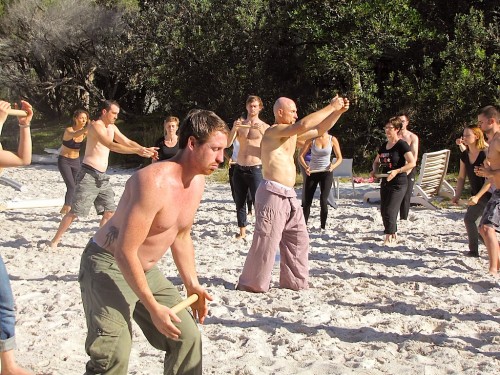
Sometimes we have an opportunity to meditate during the day.
If being active is an authentic craving, then I encourage people to begin meditating actively.
The most effective methods for active meditation are simple and repetitive.
The simplicity and repetitive nature of such meditations subdues the ego-mind, which loves complexity. As soon as the ego-mind thinks it knows what’s going on, it relaxes and becomes passive.
This is the door opening to the witness.
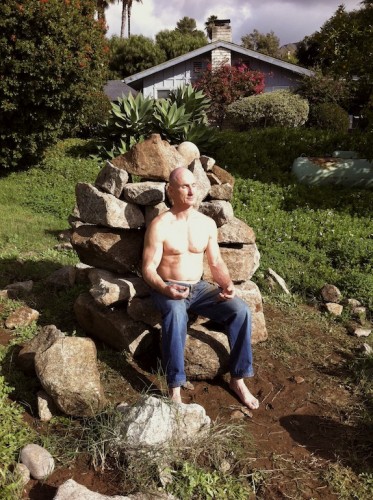
Here you can see me doing a seated meditation on my rocks at home. If the time and environment are such that sitting feels most natural to you, then it’s a great time for a seated meditation.
Again, more than “how you do it”, it’s doing it regularly that maintains the process of progressive cultivation.
If you’d like to read a great book by a true master of the meditative process, I’d like to recommend, Meditation: The Notebooks of Paul Brunton, Part 1 (Volume 4), (1986), Larson Publications, New York.
[amazon-product align=”left”]0943914191[/amazon-product]
I hope you’ve enjoyed this little lesson on meditation today and put regular time aside to meditate daily and in the process get to know yourselves at the most fundamental level.
Have a lovely rest of your day wherever you are!
Love and chi,
Paul Chek




